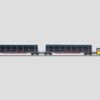Found this to be interesting. Marklin manufactures a pipe train. http://www.maerklin.de/en/prod...tails/article/26545/
In the product description:
- Locomotive constructed of metal.
- Special magnets for greater pulling power on Märklin track.
- Maintenance-free LED's for red marker lights / white headlights.
More locomotive features:
The locomotive has a digital decoder. It has a controlled miniature can motor with a flywheel. 2 axles powered, 2 track adhesion magnets for greater pulling power. The headlights and marker lights will work in conventional operation and can be controlled digitally. The locomotive has separately applied metal grab irons. The stake cars have fixed double stakes with tension levers.
I just found this interesting that others are using magnets to increasing pulling power like Lionel's magnetraction. It is understandable in this case as the locomotive is very small and needs all the electrical contact it can get.






